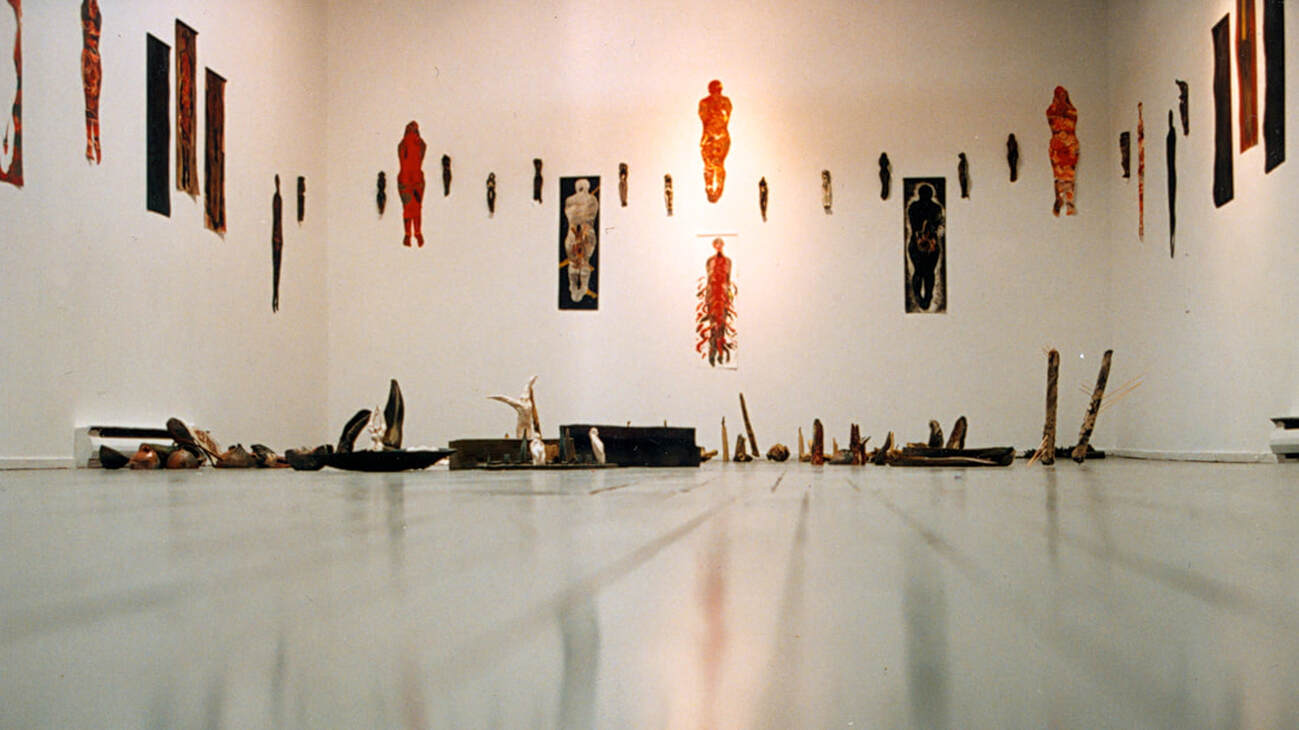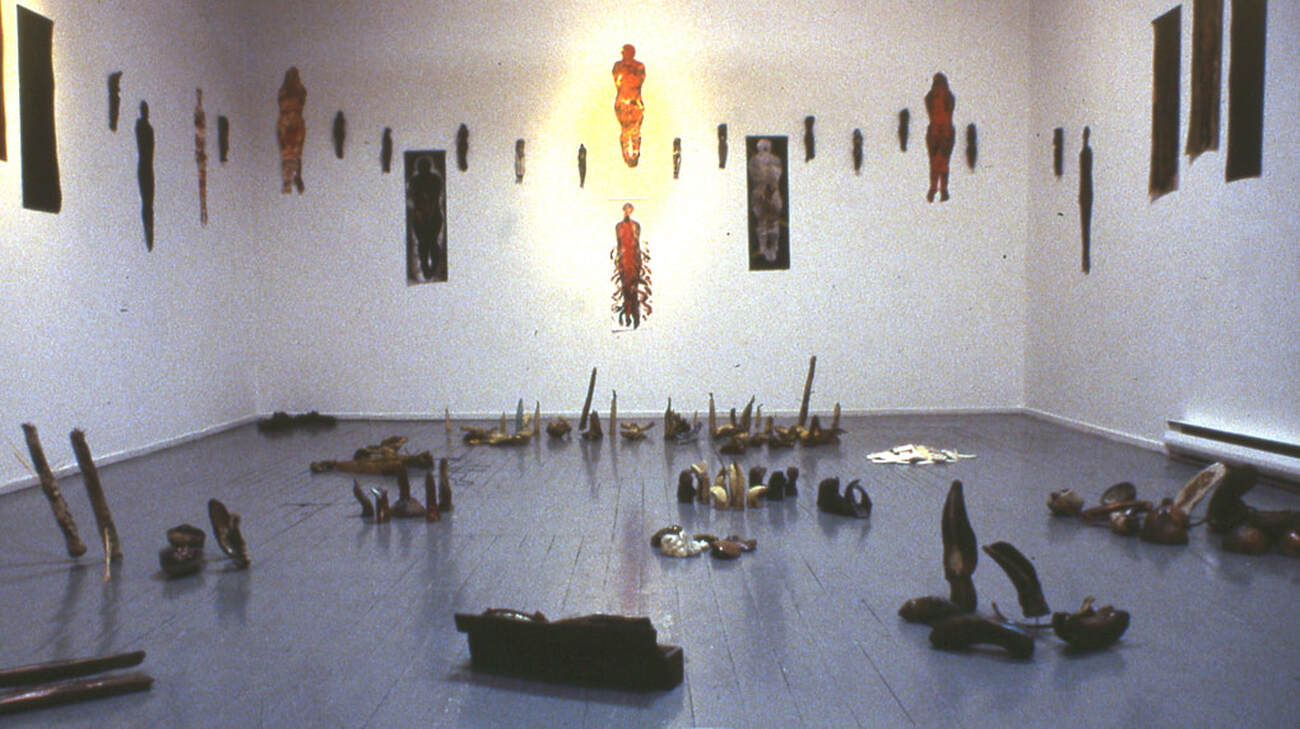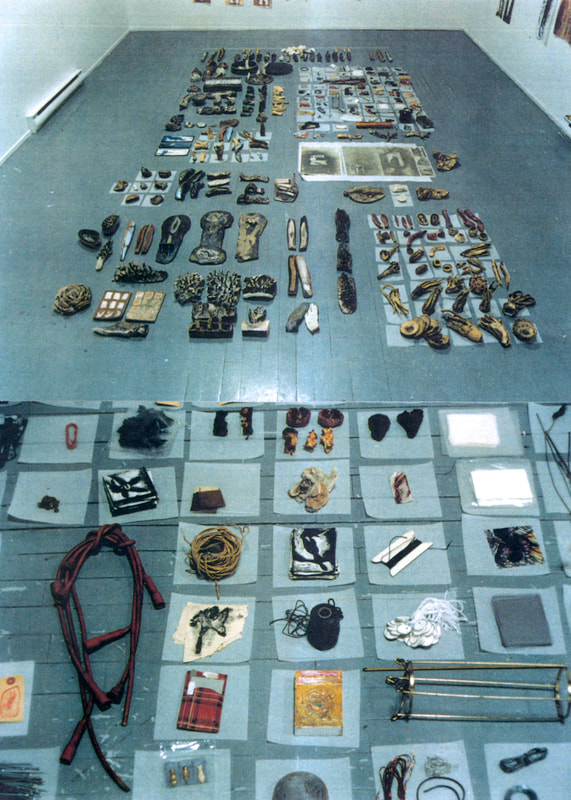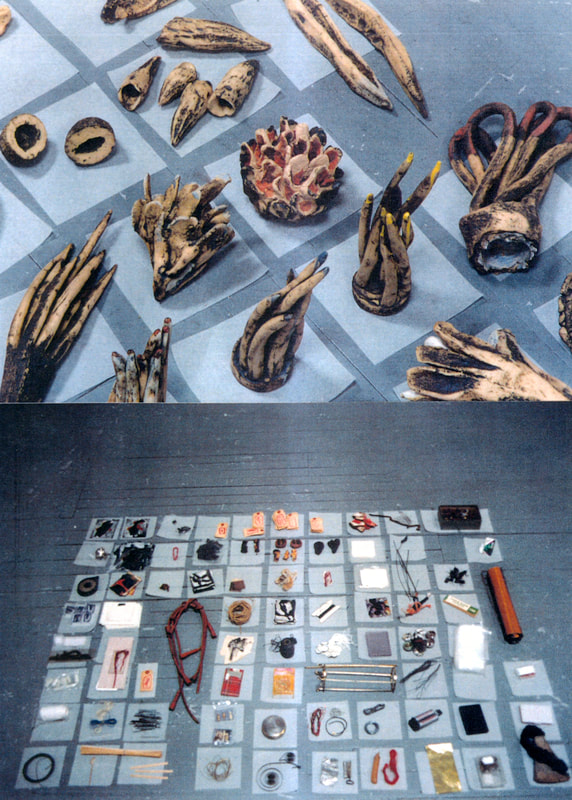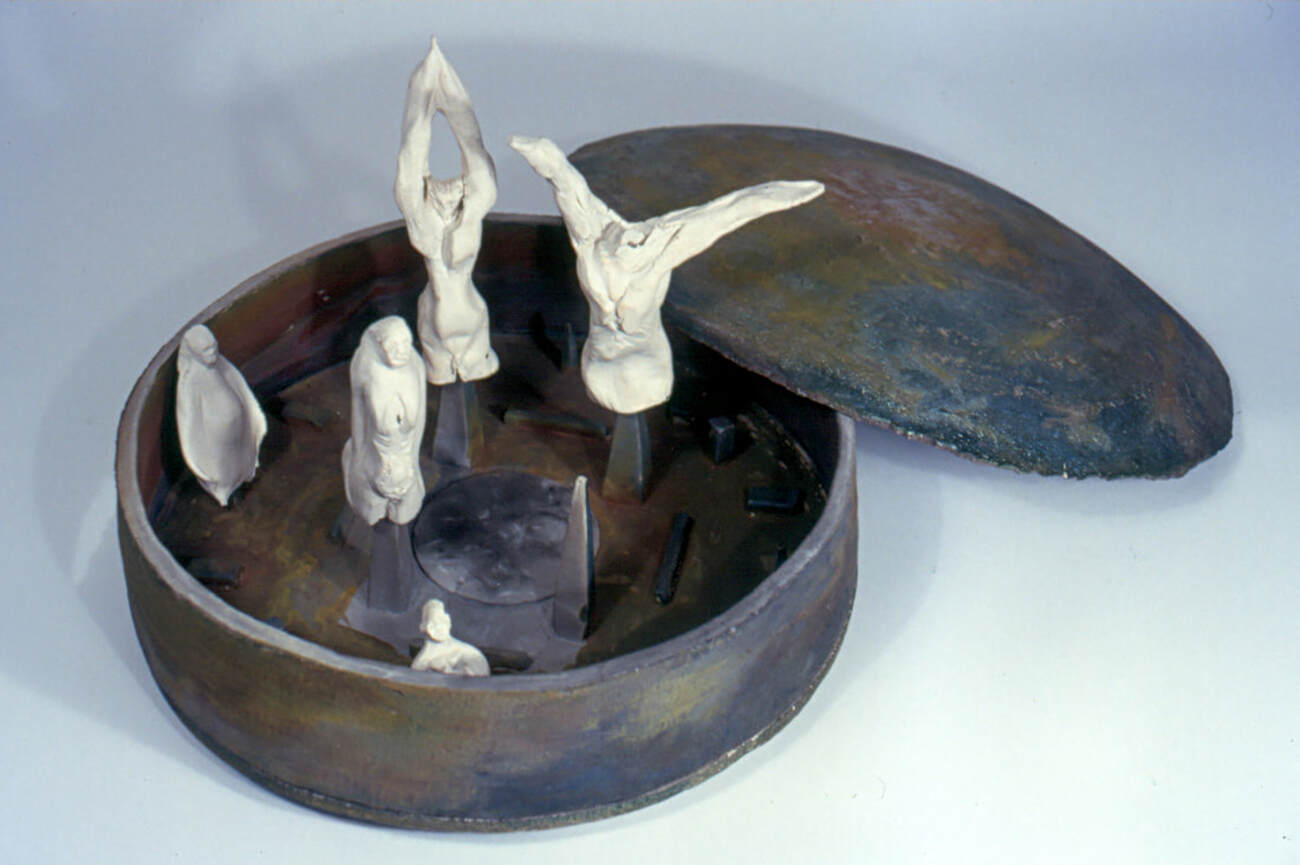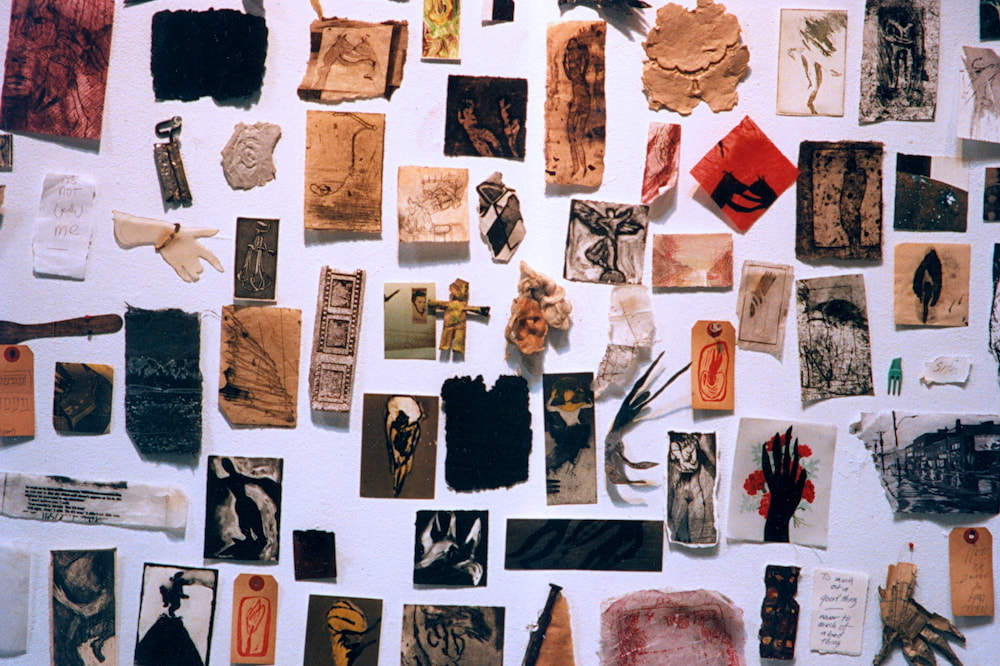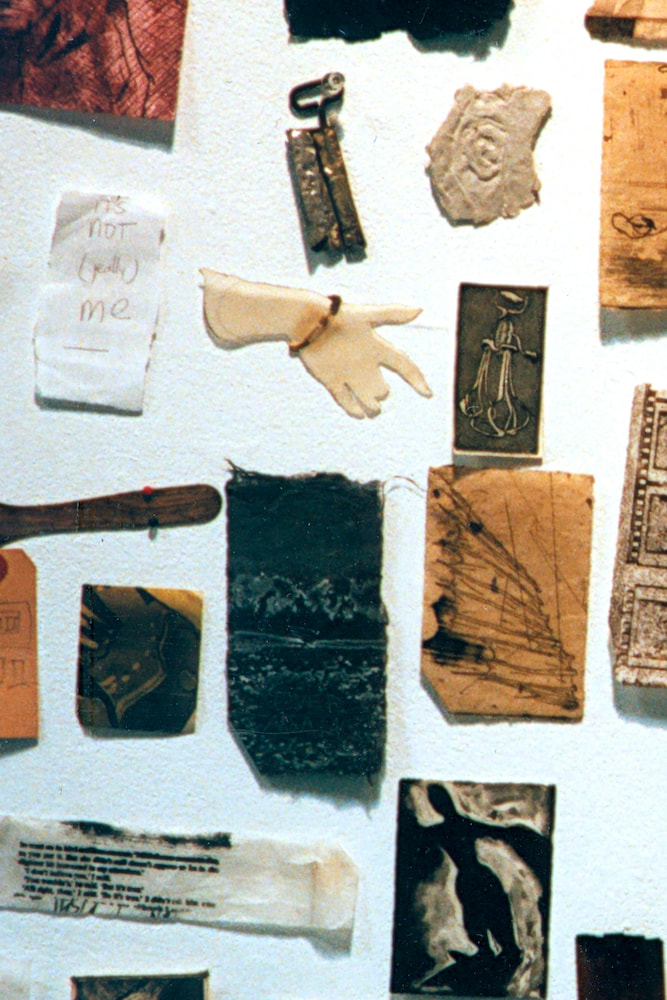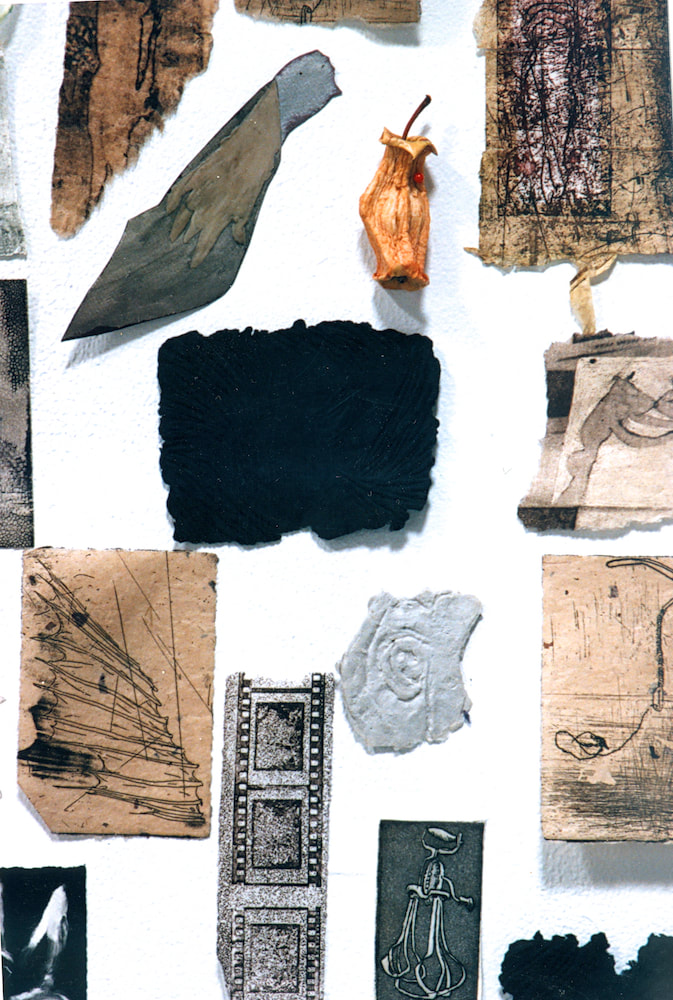"Concern for a Body of Work"
a gallery residency that occurred over a period of 3 weeks in Xchanges Gallery.
I
worked from a large scattering of art pieces, ceramics, prints, notes,
and collections of found objects towards a single installation as an
attempt to create one coherent picture, one statement, of my body's
experience, of this, my body of work.
"There was a concern to resolve/evolve, heal/ reveal, and express/impress. It was in the concern in Concern for a Body of Work that the need to connect inner and outer, mind and body came out strongly The body of meaning and the meaning of body was found through work and effort on the part of both artist and viewer." Elizabeth Mayne
"This is the garage sale stage" she said.
Victoria Edgarr seemed to have dumped all the work she had done over the past decade on the floor of Xchanges. Raku and bisque clay pieces small and large prints, drawings, sketches collages photos paper dolls wax masks: together with od bits of gauze, dried apples, rusted jewellery, hardware, copper wire, string and bits of writing, lying everywhere.
Victoria Edgarr seemed to have dumped all the work she had done over the past decade on the floor of Xchanges. Raku and bisque clay pieces small and large prints, drawings, sketches collages photos paper dolls wax masks: together with od bits of gauze, dried apples, rusted jewellery, hardware, copper wire, string and bits of writing, lying everywhere.
"She will have to dig deep to find a body buried in all this disorder" I thought. It was like coming into the studio of an artist who had lost control of the creative process. I was overcome by a feeling of confused excess and superfluity which turned into gloom. The casualness of the display, the June heat in a gallery with inadequate ventilation made me want to leave, and leave the search for meaning to someone with more energy and a less tidy mind.
But then another even stronger feeling emerged, the urge to explore, the urge that pulls one into a crowded antique market in a strange country. I sat down on the floor to look at all the stuff.
During the following days Victoria began a process of classification. She used an elaborate scheme with printed tags to categorize the objects and images. Groups were placed carefully on wax paper(squares). Themes appeared, arranged in a reverential and hierarchical manner.
During the following days Victoria began a process of classification. She used an elaborate scheme with printed tags to categorize the objects and images. Groups were placed carefully on wax paper(squares). Themes appeared, arranged in a reverential and hierarchical manner.
The garage sale was being transformed into s kind of museum.
Not a glass-case museum, but one of explanation, or searching for order and meaning.
Concern For A Body Of Work
a review by Elizabeth Mayne
"This is the garage sale stage" she said.
Victoria Edgarr seemed to have dumped all the work she had done over the past decade on the floor of Xchanges. Raku and bisque clay pieces small and large prints, drawings, sketches collages photos paper dolls wax masks: together with od bits of gauze, dried apples, rusted jewellery, hardware, copper wire, string and bits of writing, lying everywhere.
"She will have to dig deep to find a body buried in all this disorder" I thought. It was like coming into the studio of an artist who had lost control of the creative process. I was overcome by a feeling of confused excess and superfluity which turned into gloom. The casualness of the display, the June heat in a gallery with inadequate ventilation made me want to leave, and leave the search for meaning to someone with more energy and a less tidy mind.
But then another even stronger feeling emerged, the urge to explore, the urge that pulls one into a crowded antique market in a strange country. I sat down on the floor to look at all the stuff.
During the following days Victoria began a process of classification. She used an elaborate scheme with printed tags to categorize the objects and images. Groups were placed carefully on wax paper(squares). Themes appeared, arranged in a reverential and hierarchical manner.
The garage sale was being transformed into s kind of museum. Not a glass-case museum, but one of explanation, or searching for order and meaning.
Soon large prints and collages of a floating female figure were hung on one long wall, interspersed with small clay forms of women protecting their bodies. The paper images were often overlaid with cut-outs placed over breast and genital areas. The clay statues also covered up. Similar gestures could be seen in a print, dripping red, and in a mound of white clay tablets.
The feet of the floating or hanging women were of particular interest. They did not stand in strength, but were drifting as if controlled or held up by a hidden force. The bodies were strong but the feet were vulnerable and weak. The bodies were physical but without sexual display. They were confidant but protecting the interior from the exterior. Hanging in not on. The metaphor was echoed in some beautiful etchings of hanging figures in interiors.
On the floor the interior of the body was trying to emerge. A group of clay breasts had gaping or laughing mouths for nipples, and a painting of a breast with a nipple switch hung near by. An assembly of tongues looked like drooping phallic symbols. Is speech masculine? Villa and cilla the hair like structures on internal membranes clustered together reminding one of the complexity of the digestive system, and of art. A breast/hip bone lay near leg/arm bones. Sometimes rubber tubes connect the biological forms with the coffins/boxes.
Gradually the categorizing or classification began to mute the feelings of the horrible and painful always associated with body parts. Feelings of natural order took over. Aesthetics came into play. During this rearranging with formal concepts in mind, things began to flow together, the visceral quality was softened, submerging the surreal, without loosing any of the elements out of which it grew.
The stage after making and accumulating art objects is one of selecting or discarding, revealing or concealing. This process of mulling/ over, musing /sorting out of ideas and feelings usually takes place in private in the studio. Here it is being exhibited. Shaping the boundlessness and excessiveness of art was what was on display.
Many artists who work in mixed media suffer from this excessiveness. It is an exuberance and a joy-in-making which is very expressive. It is not confined at the beginning by the traditional boundaries of one medium within a frame. It is a messy energy which can overflow the boundaries of the pristine gallery exhibition.
Victoria Edgarr adapted the gallery to her own special need by also exhibiting the making of an exhibition. This selecting of work for a cohesive show is a discerning task, these days most often done by a curator. Artists do not always have clear insight into what they are doing and into the complex relationships in the work.
It is a conceptual task. Victoria was putting this essential part of making a show on show. She was breaking down the division between studio and gallery and making a closer link between artists and viewer.
She was showing us too, in this unusual exhibition, one of many kinds of art. In her imagery she was not concerned with representation, no with the concepts or the making of symbols. She was revealing an organic process and the psychological and biological foundation of her art. It was a thoughtful and active exploration of a created body of work made instinctively without conscious thought. Her objects and images gave a strong feeling of rupture or discord between the inner and outer body. This rupture made the show complex and gave it an edge.
There was a concern to resolve/evolve, heal/ reveal, and express/impress. It was in the concern in Concern for a Body of Work that the need to connect inner and outer, mind and body came out strongly The body of meaning and the meaning of body was found through work and effort on the part of both artist and viewer.
a review written by Elizabeth Mayne of an exhibition of the work of Victoria Edgarr shown during June 1995 at Xchanges Gallery
NFS Fall/Winter 1995
Xchanges
951 North Park St Vic Bc
a review by Elizabeth Mayne
"This is the garage sale stage" she said.
Victoria Edgarr seemed to have dumped all the work she had done over the past decade on the floor of Xchanges. Raku and bisque clay pieces small and large prints, drawings, sketches collages photos paper dolls wax masks: together with od bits of gauze, dried apples, rusted jewellery, hardware, copper wire, string and bits of writing, lying everywhere.
"She will have to dig deep to find a body buried in all this disorder" I thought. It was like coming into the studio of an artist who had lost control of the creative process. I was overcome by a feeling of confused excess and superfluity which turned into gloom. The casualness of the display, the June heat in a gallery with inadequate ventilation made me want to leave, and leave the search for meaning to someone with more energy and a less tidy mind.
But then another even stronger feeling emerged, the urge to explore, the urge that pulls one into a crowded antique market in a strange country. I sat down on the floor to look at all the stuff.
During the following days Victoria began a process of classification. She used an elaborate scheme with printed tags to categorize the objects and images. Groups were placed carefully on wax paper(squares). Themes appeared, arranged in a reverential and hierarchical manner.
The garage sale was being transformed into s kind of museum. Not a glass-case museum, but one of explanation, or searching for order and meaning.
Soon large prints and collages of a floating female figure were hung on one long wall, interspersed with small clay forms of women protecting their bodies. The paper images were often overlaid with cut-outs placed over breast and genital areas. The clay statues also covered up. Similar gestures could be seen in a print, dripping red, and in a mound of white clay tablets.
The feet of the floating or hanging women were of particular interest. They did not stand in strength, but were drifting as if controlled or held up by a hidden force. The bodies were strong but the feet were vulnerable and weak. The bodies were physical but without sexual display. They were confidant but protecting the interior from the exterior. Hanging in not on. The metaphor was echoed in some beautiful etchings of hanging figures in interiors.
On the floor the interior of the body was trying to emerge. A group of clay breasts had gaping or laughing mouths for nipples, and a painting of a breast with a nipple switch hung near by. An assembly of tongues looked like drooping phallic symbols. Is speech masculine? Villa and cilla the hair like structures on internal membranes clustered together reminding one of the complexity of the digestive system, and of art. A breast/hip bone lay near leg/arm bones. Sometimes rubber tubes connect the biological forms with the coffins/boxes.
Gradually the categorizing or classification began to mute the feelings of the horrible and painful always associated with body parts. Feelings of natural order took over. Aesthetics came into play. During this rearranging with formal concepts in mind, things began to flow together, the visceral quality was softened, submerging the surreal, without loosing any of the elements out of which it grew.
The stage after making and accumulating art objects is one of selecting or discarding, revealing or concealing. This process of mulling/ over, musing /sorting out of ideas and feelings usually takes place in private in the studio. Here it is being exhibited. Shaping the boundlessness and excessiveness of art was what was on display.
Many artists who work in mixed media suffer from this excessiveness. It is an exuberance and a joy-in-making which is very expressive. It is not confined at the beginning by the traditional boundaries of one medium within a frame. It is a messy energy which can overflow the boundaries of the pristine gallery exhibition.
Victoria Edgarr adapted the gallery to her own special need by also exhibiting the making of an exhibition. This selecting of work for a cohesive show is a discerning task, these days most often done by a curator. Artists do not always have clear insight into what they are doing and into the complex relationships in the work.
It is a conceptual task. Victoria was putting this essential part of making a show on show. She was breaking down the division between studio and gallery and making a closer link between artists and viewer.
She was showing us too, in this unusual exhibition, one of many kinds of art. In her imagery she was not concerned with representation, no with the concepts or the making of symbols. She was revealing an organic process and the psychological and biological foundation of her art. It was a thoughtful and active exploration of a created body of work made instinctively without conscious thought. Her objects and images gave a strong feeling of rupture or discord between the inner and outer body. This rupture made the show complex and gave it an edge.
There was a concern to resolve/evolve, heal/ reveal, and express/impress. It was in the concern in Concern for a Body of Work that the need to connect inner and outer, mind and body came out strongly The body of meaning and the meaning of body was found through work and effort on the part of both artist and viewer.
a review written by Elizabeth Mayne of an exhibition of the work of Victoria Edgarr shown during June 1995 at Xchanges Gallery
NFS Fall/Winter 1995
Xchanges
951 North Park St Vic Bc
Concern for a Body of Work is a gallery residency that occurred over a period of 3 weeks in Xchanges Gallery.
I worked from a large scattering of art pieces, ceramics, prints, notes, and collections of found objects towards a single installation as an attempt to create one coherent picture, one statement, of my body's experience, of this, my body of work.
The body in clay objects and on slips of paper. hands, hearts, guts, shapes and skins, the insides and outsides, are brought together here.
Four same poses, attitudes, of a body, are expressed in a set of fired clay figures and a suite iterations of shaped monoprints.
The residency covers different phases; a time of accumulation, of taking stock, a period of grouping, arranging, and construction into sentences, pararaphs, conversations.
Attitudes 1, 2, 3, monoprints 30" x 10"
#7. etching 3 x 2" each block
"Tree" 72" x 72"
#9. Tree detail
#10,11 accumulation, assemblage 8.5 x 11

